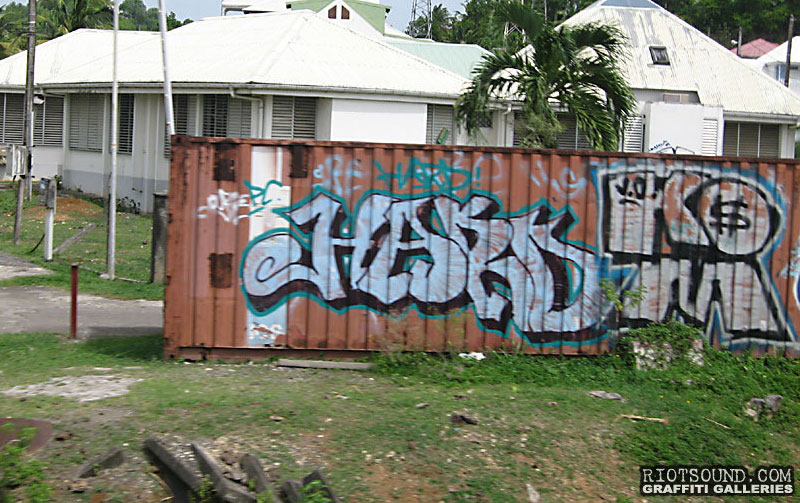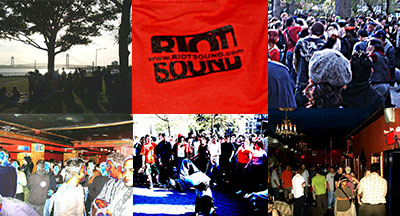CHECK OUT THE BOMB IT TRAILER!!
by Alex Shtaerman
No stranger to provocative filmmaking, acclaimed director Jon Reiss has done everything from directing music videos for the likes of Nine Inch Nails, Slayer and The Black Crowes to chronicling the west coast punk scene to releasing the seminal American rave culture narrative Better Living Through Circuitry. However, it is Jon’s latest project that may represent his most ambitious work to date. Traveling across five continents and to cities such as New York, Sao Paulo, Tokyo, Berlin, Barcelona, Cape Town, Los Angeles, Amsterdam, Paris and London, Jon delivers his vivid and vibrant account of the global explosion in graffiti art and culture in his brand new documentary Bomb It. Featuring well over 100 artists from around the world including subway art pioneers and graff legends such as TRACY 168, TERRIBLE T-KID, COPE 2, ZEPHYR, CORNBREAD, TAKI 183, LADY PINK and STAY HIGH 149, Bomb It is a gripping and gritty look into the culture, lifestyle and artform that’s come to dominate urban landscapes in the New World, the Old World and everywhere in between.
Through often striking interviews, footage of graffiti artists in action and social commentary, Jon depicts the global graffiti movement in a vein eerily reminiscent of the classic 1983 subway art documentary Style Wars. While standing alongside greatness is often a difficult task, Jon is hopeful that Bomb It is not just another entry in a vast catalogue of films about street art. “We like to think and we hope that it’s the best film about graffiti since Style Wars. We like to think it’s the Style Wars of the current generation in a sense and we hope it becomes that,” explains the director, quickly adding “I don’t want to be egotistical but we’re hoping that people view it in that way”. One thing is for sure, regardless of whether you are a graffiti writer, graffiti enthusiast or just completely ignorant about graffiti, Bomb It is a film that is sure to keep your attention.
Click here to read the RiotSound.com interview with TERRIBLE T-KID 170, a legendary NYC writer prominently featured in Bomb It.
RIOTSOUND.COM: With Bomb It you’re taking an in-depth look into graffiti art and culture across a global landscape. Initially, how much did you have to immerse yourself into the culture to get an idea of the direction you wanted to go in? How much of the film’s subject matter was actually contemplated in advance and how much of it was something that happened spontaneously?
JON REISS: Nothing was done in advance [laughs], not one bit. To be perfectly honest, [the idea for the film] actually started as research from another project. A friend of mine, this woman I had met while working on Better Living Through Circuitry – that’s one of the things that I love about doing documentaries is that you meet new people and you stay friends with a number of them, and you kind of end up forming these life long friendships, [at least that has been my experience] with the documentaries that I’ve done. And so I was telling her about this thing I was thinking of doing and she says – oh, I’m a writer and I know some writers in New York. It turns out that one of the things I discovered is a lot of people who ended up DJing, not only at the very beginning of DJ culture – like Kool Herc was a writer before he was a DJ – but even people later on like Frankie Bones and others…
RIOTSOUND.COM: Adam X is a great example of that too as someone who is so prominent in both cultures…
JON REISS: Actually as you bring up Adam, I should have contacted [him] but it just became too crazy with all the people that we were going after. What happened first is my friend introduced me to SHARP from New York and also to Mike Baca, who is now with the ACC crew, he’s always been 2ESAE but he wasn’t with the ACC crew at the time. So Mike took me out and took me around. Also SHARP, who’s an old school guy, took me to all the Hall of Fames and we drove around and we talked about the history of graffiti and then that same night Mike brought me on my first bombing raid. After both interviews I would say I was “half-hooked”, let me put it that way.
I saw that there was a lot of depth in the culture that you didn’t just see by driving by the stuff or walking by the stuff in the street. I’ve always been kind of fascinated and appreciative of street art and graffiti because I really liked the pieces and the work that I would see. But I didn’t frankly know that much about it. So, little by little as we got into the documentary, more and more stuff revealed itself, and that’s also how I did Better Living Through Circuitry. I would say that’s pretty much my approach to documentaries in general. I usually just start off interviewing people from my own perspective, which is kind of an outsider’s perspective, which I think is better because I ask questions that will allow me to [create] a documentary that makes sense for people who aren’t into the culture. The film has always been for people who aren’t just in the culture, of course for people who are in the culture as well, but also for people who don’t know that much, which is the larger audience outside, which I think needs to be spoken to and isn’t normally involved in the dialogue about graffiti.
The dialogue that exists usually involves the cops, a few angry citizens and the writers, and I think there is a much bigger culture at stake in a sense. So, because of this outsider perspective that I have, I think I go into it doing the interviews in a way where I’m kind of pealing back layers. For instance, one of the things that SHARP said to me, which was my first interview I did, he said – oh my god, I’ve done hundreds of interviews and no one’s ever asked me these type of questions before. And I think because I’m an outsider and I didn’t have any pre-conceived notions when I started working on the documentary, I think it allows me to come from a different place than from where most people approach graffiti culture from.
It’s funny because one of the first times I went to the TKO yard in Los Angeles, they thought I was a cop! They kept on asking me – what are you doing here, what are you taking pictures for, you’re a cop right? And I was like – I’m not a cop, man [laughs]. And it really kind of perturbed me because I originally started doing documentaries in the punk rock scene and so to be considered a cop was… surprising, let me put it that way. But for them I’m like some middle aged straight guy, you know, like, who’s this guy? Which in a sense, to me, it was terrifying to be considered a middle aged straight guy…
RIOTSOUND.COM: [Laughs]
JON REISS: But I guess that’s what I am these days, you know.
“I think it makes your documentary stronger if you
include as many points of view as possible. Because
I think if you don’t do that people will say – oh,
they’re just one sided and they’re just pro-graffiti”
RIOTSOUND.COM: During the filming of Bomb It you visited cities around the world including New York, Tokyo, Paris, Sao Paulo, Amsterdam, Cape Town, Paris, Barcelona, Hamburg as well as some others. How did you pick the locations where you were going to shoot, and also, were there any cities that you would have liked to visit but didn’t get a chance to?
JON REISS: Well, first of all, I want to say that coming from an outsider perspective is how we approached the film but I do want to be fair and say we did do some research on [the global graffiti scene]. Tracy [Wares], who’s the producer and director of photography for Bomb It, she did a fair amount of research. Once we decided to commit [to the project] we did look at things and examine the culture a bit. In talking to people with the research that we did, it just seemed that certain cities were important to go to. Obviously New York and Philadelphia, we did go to San Francisco but not as much as we would have liked, that’s one city that I would have liked to have gone to more, also, of course we went to L.A.
In Europe, I think by going to London, Paris, Barcelona and Berlin we hit most of the major spots, and then we also went to Hamburg and Amsterdam. I would have liked to have gone to Milan because there’s a lot of stuff going on there. Also I would have liked to have gone to Madrid because there is actually a pretty interesting scene going on there. Part of what caused us to go [to certain cities] was the research and also people just hooking us up with people in different places. Top on my list of places I wish we would have gone [but didn’t get a chance to] would be Melbourne, Australia because I know there’s a big scene there and it’s pretty interesting and also it would have been our sixth continent – I guess I would have liked to have gone to Antarctica and hit every single continent in the world…
RIOTSOUND.COM: [Laughs]
JON REISS: I would have also liked to have gone to Jerusalem to film some of the stuff that BANKSY did there and also just hit the Middle East a little more in general. Had I had an unlimited budget I would have gone [to even more places], I would have gone more to Asia, because graffiti art is all over the world now. But I do feel like besides missing Melbourne and Milan, we were able to hit all the major centers of it.
RIOTSOUND.COM: One thing that I found very interesting about Bomb It is that you also give airtime to the various opponents of graffiti; people who seek to either rid their neighborhoods of graffiti or enforce laws banning various forms of street art and so on. How did you decide to include this aspect and also how did you go about approaching some of these individuals who so vehemently despise graffiti and convince them to be in the film?
JON REISS: I think it makes your documentary stronger if you include as many points of view as possible. Because I think if you don’t do that people will say – oh, they’re just one sided and they’re just pro-graffiti – and then people dismiss [what you’ve done]. I think to an extent the reason that people have problems with graffiti is that there are some valid issues. A lot of graffiti writers don’t consider whether they are screwing up someone’s personal property, like cars and stuff like that. And I think that’s offensive to some people and I think we addressed that in the documentary. [In the past] there used to be a code of not painting on churches, not painting on schools, not painting on people’s cars and homes. And now that graffiti has spread around the world there’s some people who still abide by that but there’s some other people who just don’t care and just do whatever they want, which is, you know, kinda uncool and kinda causes people to get pissed off.
So I think there’s some validity in their reasoning or their concern; the problem, however, lies in the way they may go about expressing those concerns. We have to remember that graffiti has always been a form of political expression and when you start banning it you essentially start banning free speech and a way for people to express their political ideas besides just their artistic ideas. So you have to be very cautious about that and that’s one of the things that I felt was important for us to express in the film, the fact that this is a hot-button issue. You can look at it in terms of how torture is dealt with by the US government. It used to be that the United States would never get involved with torture, and now people are saying – oh no, we need to torture to protect ourselves. At a certain point you have to remember what this country [stands for] and what liberties are about and look at it in that kind of frame. But I don’t think it would have been even possible to bring up [the issue of free expression] had that other point of view not been shown.
In terms of how we approached it is we went after certain people and tried to get in touch with them; like Karl Hannig in Germany [of the NoFitti organization], Valerie Hill from T.A.G, the Totally Against Graffiti organization in Los Angeles. Those were people that we found out about and wanted to speak to specifically and fortunately we were able to talk to them. Also we talked to government officials in Sao Paulo who happened to be much more understanding of graffiti and much more aware of the line between freedom of expression versus people’s private rights. But some of the people we also met at random. In one case this guy, the very thin guy [featured in the film], the one who’s talking about how graffiti is anarchy, he actually found out about our website and he started sending me all these vituperative emails like – oh, I bet you live in some really nice house, tell me your address so I can send some taggers out to tag your house and see how you like it?!
RIOTSOUND.COM: Now, is this the guy who’s talking about how a working class neighborhood can decay into a slum once graffiti comes around?
JON REISS: Yea, yea, yea, exactly. So he was sending me all these angry emails and I said – well ok, I can interview you and you can express your point of view. I told him I would be happy to represent his point of view in the film, because I don’t want it to be just one sided. So he agreed and that’s how that came about, from him emailing us through the website.
RIOTSOUND.COM: Would you say it ended up being a positive experience for him? Was he happy that he had the opportunity to at least try to get his point across?
JON REISS: Well, you know, he’s kinda cynical, he said – I know you’re interviewing me, but you’re probably going to make me look like a fool.
RIOTSOUND.COM: I didn’t think he was made to look that way, he just expressed his point, which I guess, to him, that’s what makes sense; but I didn’t feel there was any kind of negative spin put on him or what he was saying.
JON REISS: Yea, no [I didn’t think so either]. I said to him – look, I am going to try to express you as clearly as you say and we’ll see what happens and I hope you don’t feel [I am trying to make you look foolish], and if you do than I’m sorry. But I told him – if you feel this way, you gotta give it a shot and express yourself. And he did and, you know, he was a nice guy, a funny funny character, but he was a nice and reasonable person. And I understand that his truck was tagged on and that can be thousands of dollars of repairs and it sucks and it’s unfortunate that writers go out and do that. I think REVOK said it best when he said – I don’t want people tagging on my door, I don’t even want them knocking on my door, I don’t even want to see them.
RIOTSOUND.COM: [Laughs]
JON REISS: You know, there’s plenty of other places to paint where you don’t have to paint on people’s private property and you don’t have to paint on nice buildings, you don’t have to paint on things that actually already look good. There’s plenty of things in this world that look terrible that could use a coat of paint. In every city there are places that are totally butt-ugly that can use some life. So that’s my personal feeling and I know people disagree with me but I think we tried to convey that in the film, the aspect of having a little bit of social responsibility with your anarchy.
“One of the things about graffiti writers is that they have
a lot of different skill sets and can apply that. But I do
find that plenty of them still struggle with that. I’d like to
think that the film reflected that struggle”.
RIOTSOUND.COM: Since completing the film how has your impression of graffiti art and graffiti culture changed? What was the biggest difference for you afterwards as far as how you perceived graffiti?
JON REISS: Well, I’m not even done with it because we’re still releasing the film and that’s a ton of work and hopefully we are going to be also putting out more DVDs from all the material we shot where there will be DVDs coming out every year. But I can tell you the way my attitude changed most was originally we weren’t even going to include tagging in the film at all. Which just shows you how naïve I was at the very beginning of it; we were going to focus on just the beautiful pieces and not the “ugly” tags. If you’re into the culture you’re probably chuckling now from me saying that because one of the things that I found is that tags are an integral part of the culture.
And besides realizing that, that you can’t have the beautiful pieces without the tags, the other end of it is that I actually started appreciating tags more than a lot of burners or pieces, especially the pieces that people spent days on. I think KID ACNE said it best – if you spend more than two or three hours on a piece it sort of starts to lose it’s energy, it starts to become a little bit too much of a precious object. And part of street culture is that this stuff has immediacy and power, it’s almost like an action painting in a sense. So a nice droopy tag with really nice letter form I tend to appreciate as much or more than a piece now. So I would say that my aesthetics about the culture changed significantly over the course of making the film.
RIOTSOUND.COM: Another very interesting debate that arises in Bomb It is the whole issue of public space and public domain; the question of course being, who owns the rights to the public areas? Is it the people, the government, corporations? With regard to cultural differences across different countries and continents, where would you say the issue is most fiercely debated? It seems intuitive that perhaps the concept of public space would vary across different cultures; did you find that to be the case?
JON REISS: Well, to be honest, I don’t think it varied so much across cultures. I think that in some cities there was a greater appreciation of the artistic nature of graffiti, like in Barcelona and Sao Paulo, both of those cities sort of have a notion of keeping public space “pure” in a sense. Barcelona has extremely strong restrictions on billboards and Sao Paulo recently banned billboards. But most cultures are kind of in a hyper state of capitalism, all over the world. For instance when I was in Estonia, which is a former Soviet republic, I noticed it doesn’t take companies very long to go in and put billboards up everywhere. I found it in general a relatively universal attitude that if you own property you control the rights of what you can do with that property even to the point of erecting a huge billboard on that property or draping something against a building wall even though it affects everyone in the surrounding area. So I found that kind of notion of property rights as relating to property ownership generally trumps everything else.
RIOTSOUND.COM: In a way I felt the film portrayed many graffiti artists as largely marginalized individuals struggling to get their message out but often not receiving too many accolades for their work. In a general sense, would you say you found that to be the case?
JON REISS: I find that there are a few [graffiti artists] that are living by what they do and I think that trend is increasing lately. Like Shepard Fairy is an example, CLAW is an example, Tats Cru is an example. So there are those people but I did find that the majority of people are just getting by.
RIOTSOUND.COM: So basically a lot of these very talented people are still living on the fringes?
JON REISS: I think that’s true. I think some people do very well but the majority of [graffiti artists] are still struggling and, you know, the life of the artist is that. I think there’s always going to be a few people who do really well and the rest of the people, hopefully they can get by. But I think there are artists who are becoming more successful now, one of the positive effects of BANKSY selling [his works] for so much money is that brings up the price of everyone else’s work and that allows people to survive a little better through their artwork than they would otherwise. But that [only works] for people who are able to make that transition into the art world, which is not everyone.
Other people may find other avenues. Some people become graphic designers or work in some other art-related professional capacities. One of the things about graffiti writers is that they have a lot of different skill sets and can apply that. But I do find that plenty of them still struggle with that. I’d like to think that the film reflected that struggle, the reality that some were just getting by and some were successful. The positive side of the success is that you always strive to make a living with your art, and I [can relate to that] because I’m someone who hasn’t really found that balance yet [laughs]… you know what I mean? For some reason I find myself committed to doing more edgier projects or just more subversive kinds of things. And for some reason they just aren’t as commercial. So I can certainly sympathize with those people who are just getting by with their art.
RIOTSOUND.COM: When can we expect to see Bomb It in theaters?
JON REISS: It’s going to be in theaters starting the beginning of April through May and then it’s coming out on DVD May 27th. Even after May 27th there will still probably be some screenings around the States. People can check out the website www.BombIt-TheMovie.com and there we have a calendar of upcoming screenings. As we book things up that’s where all the information will be. And then after that, hopefully by the end of this month or the beginning of April, we’ll also have our store up with posters, stickers and t-shirts, and eventually we’ll be selling the DVD through the site. If you buy something you’ll be on our email list and we’ll keep you posted on when new DVDs will be coming out. We’re hoping to do one on New York, one on Los Angeles, one on Europe, one on Sao Paulo, one on Japan and one on South Africa, at least as a start.
RIOTSOUND.COM: So these are going to be new additional films?
JON REISS: Yes, these will be additional films.
RIOTSOUND.COM: What made you decide to make Bomb It into an ongoing series?
JON REISS: Well, we realized early on that we were shooting a lot of material and we knew that very little of it was going to make it into the first film. So we sort of thought to ourselves that we were going to be doing more things [down the line]. It’s just a matter of getting everything organized and finding the right people to edit the footage. For example, the editor sitting in the room with me who’s been cutting a lot of trailers and webisodes that we’re going to be releasing starting in April, he actually speaks Japanese and he’s looking forward to finding the time to cut the Japanese documentary. So that might be one of the first ones we do. So it’s just a matter of just finding the right people to do the projects.
RIOTSOUND.COM: Thank you for taking the time out to speak with us, and I just wanted to mention how much I enjoyed the film. The dialogue in it as well as all the different angles presented… I thought it was really top notch stuff.
JON REISS: We like to think and we hope that it’s the best film about graffiti since Style Wars. We like to think it’s the Style Wars of the current generation in a sense and we hope it becomes that. I don’t want to be egotistical but we’re hoping that people view it in that way. And people have commented on that so I think we really made a large effort to kind of rise above the normal docs that are out there.
For more new and info on Bomb It please visit www.BombIt-TheMovie.com

































Comments